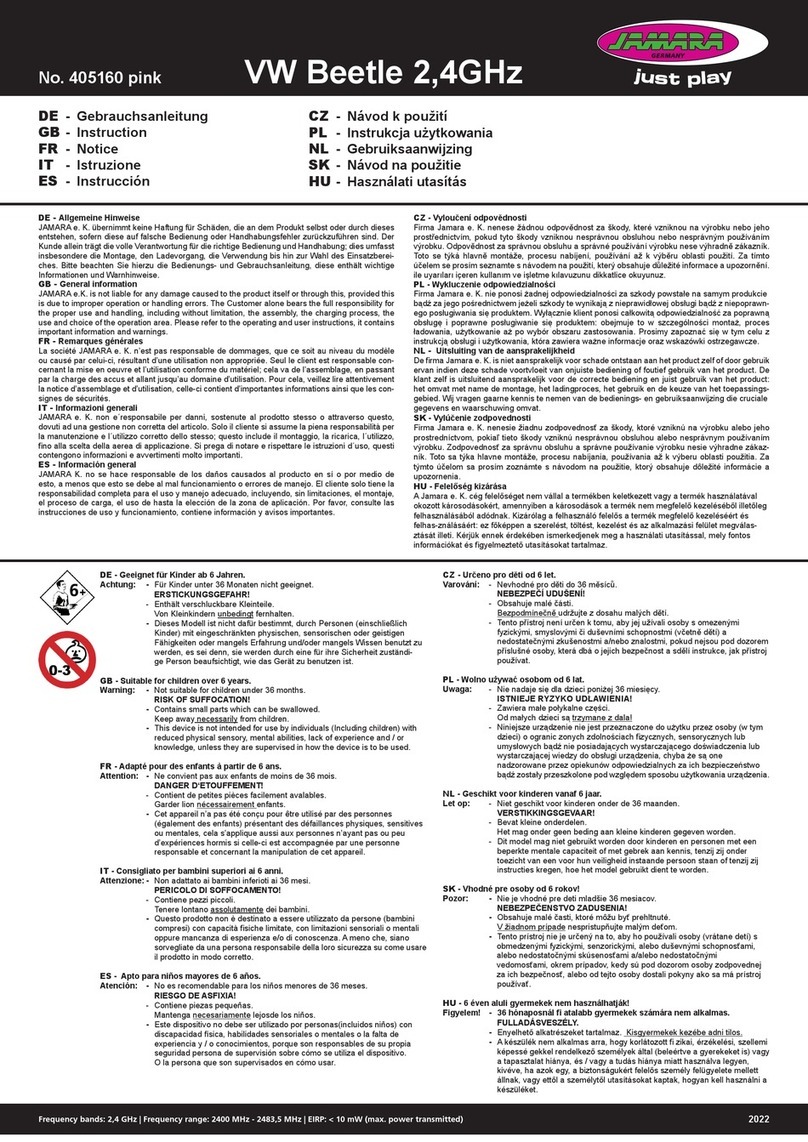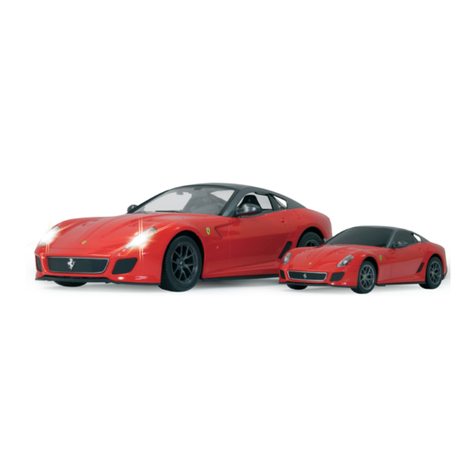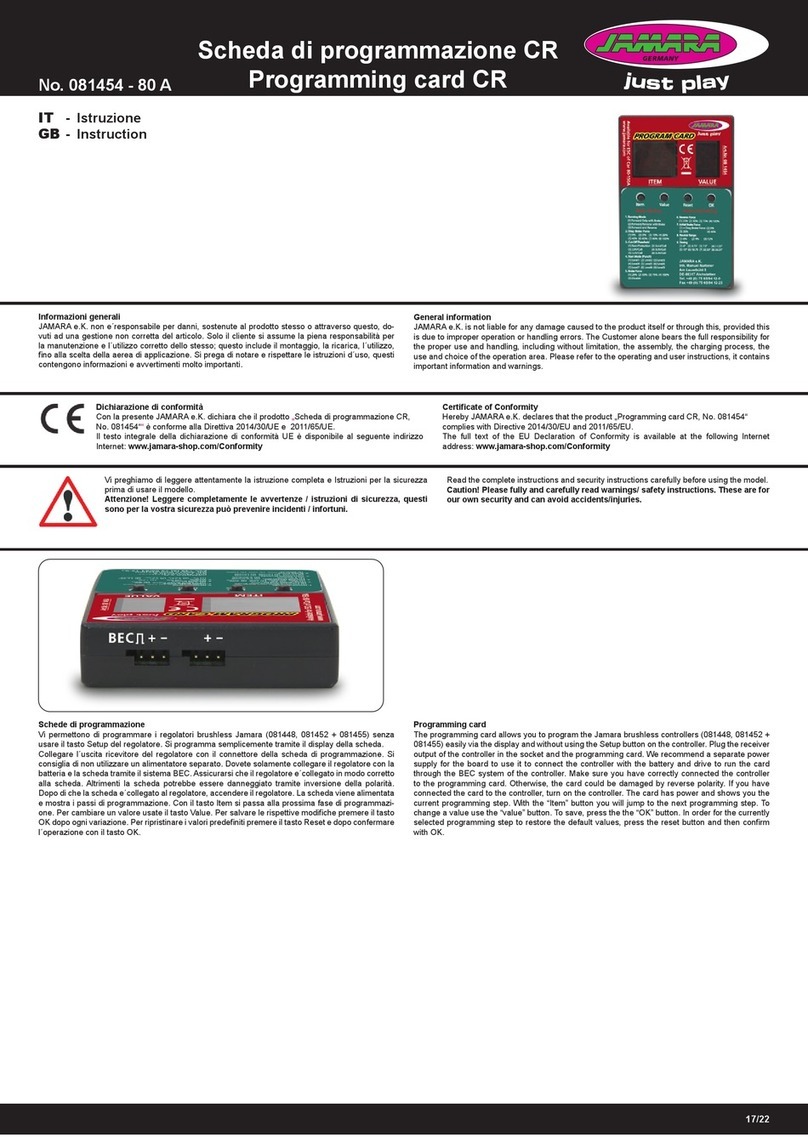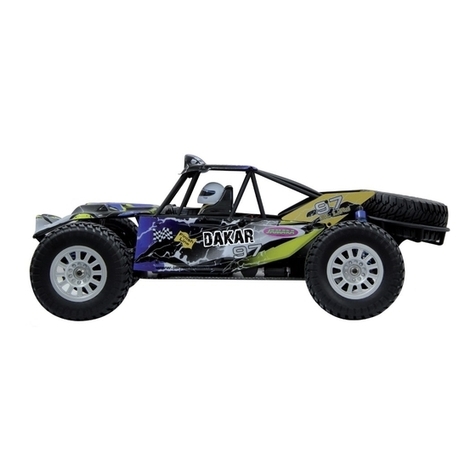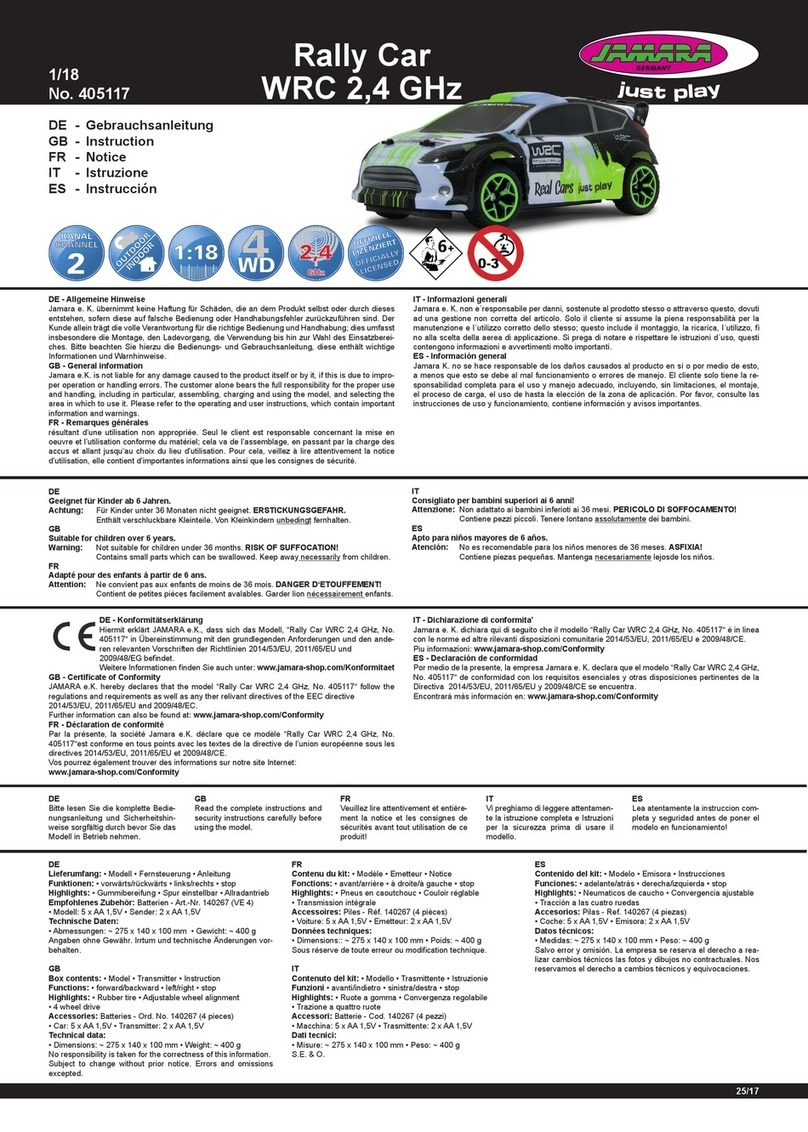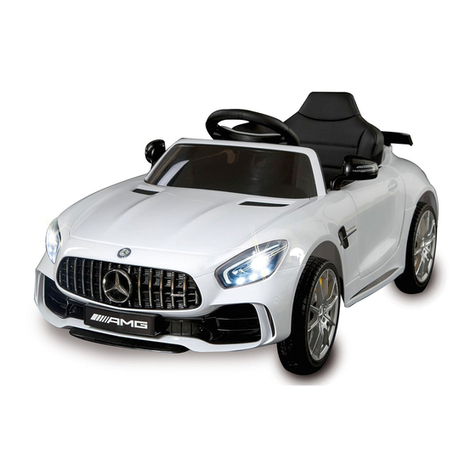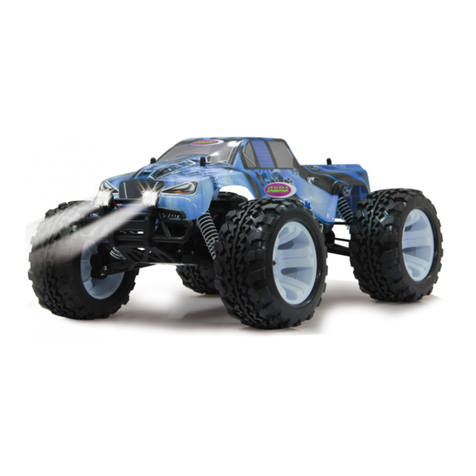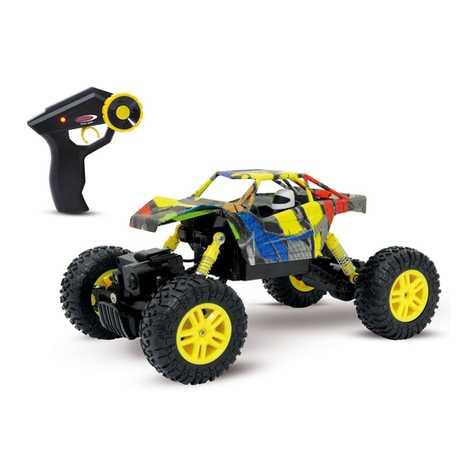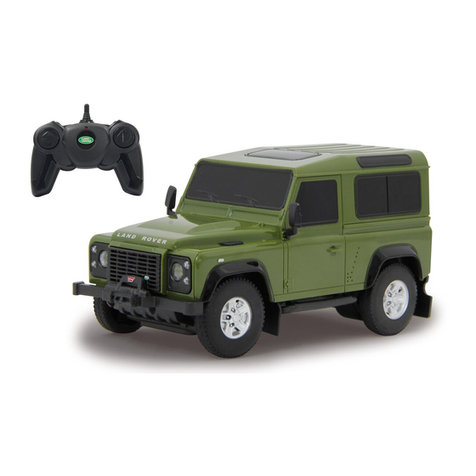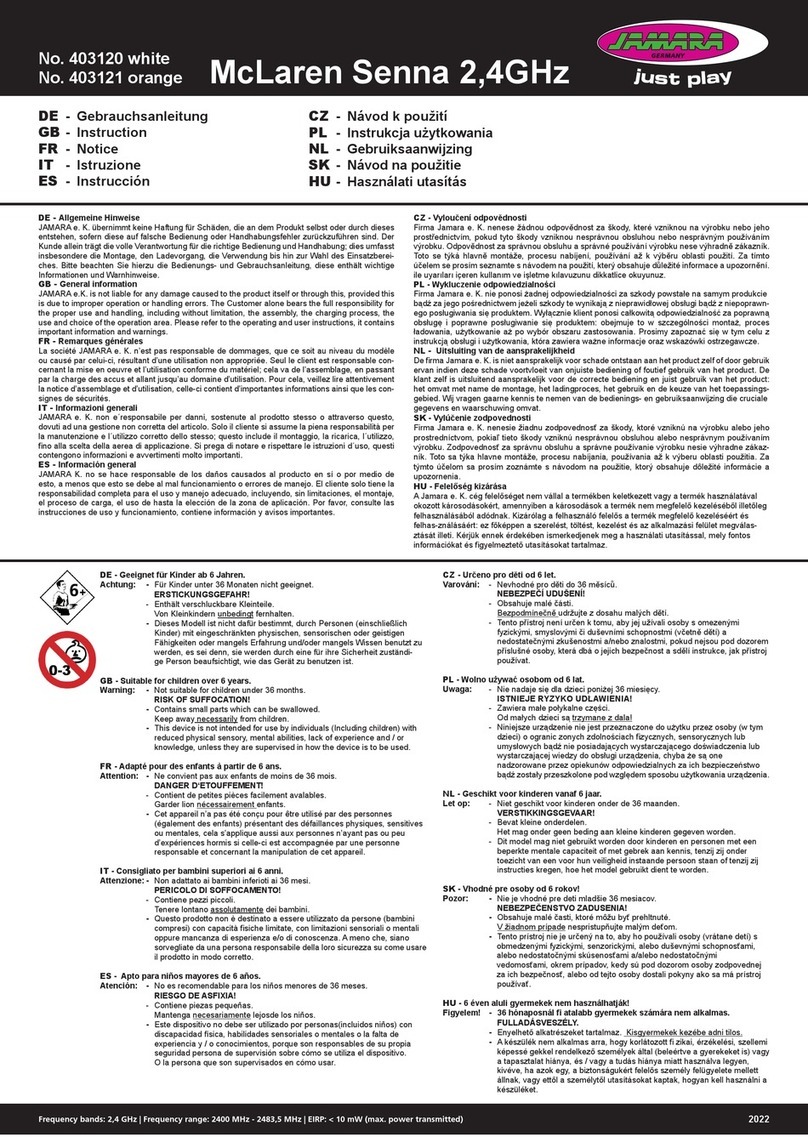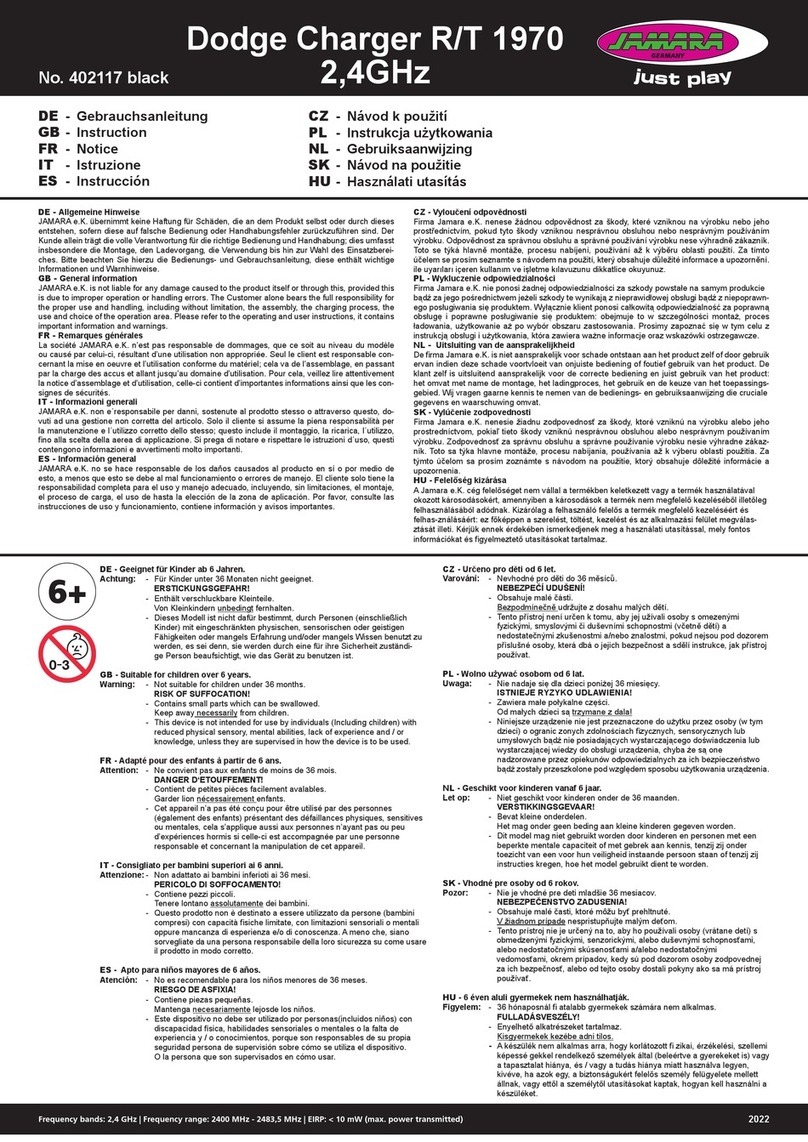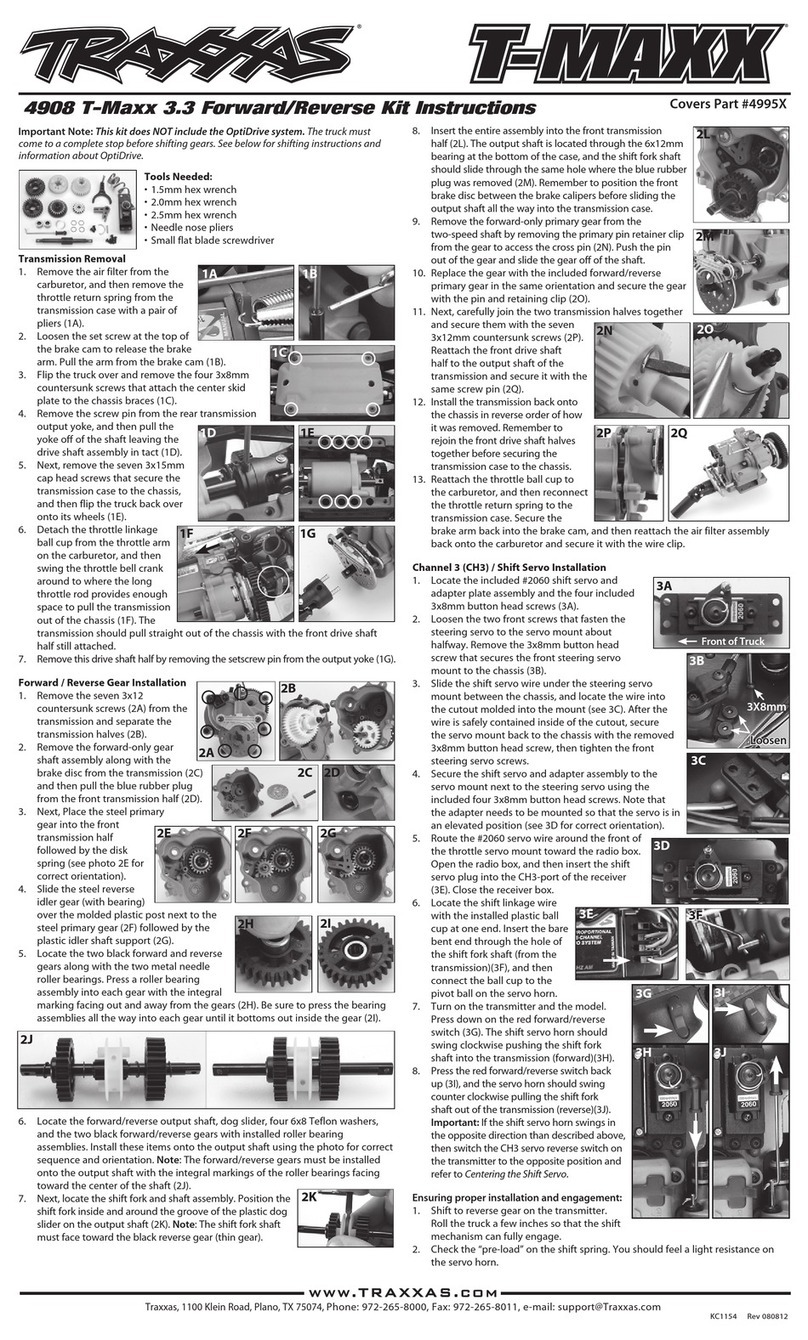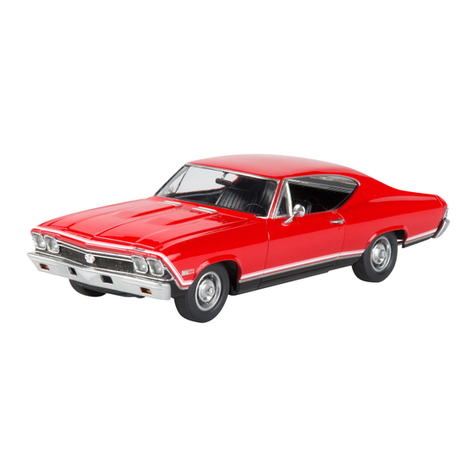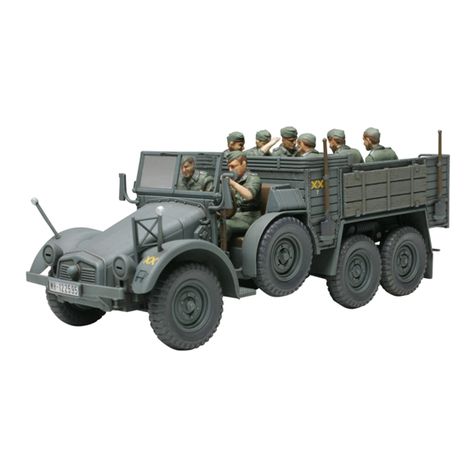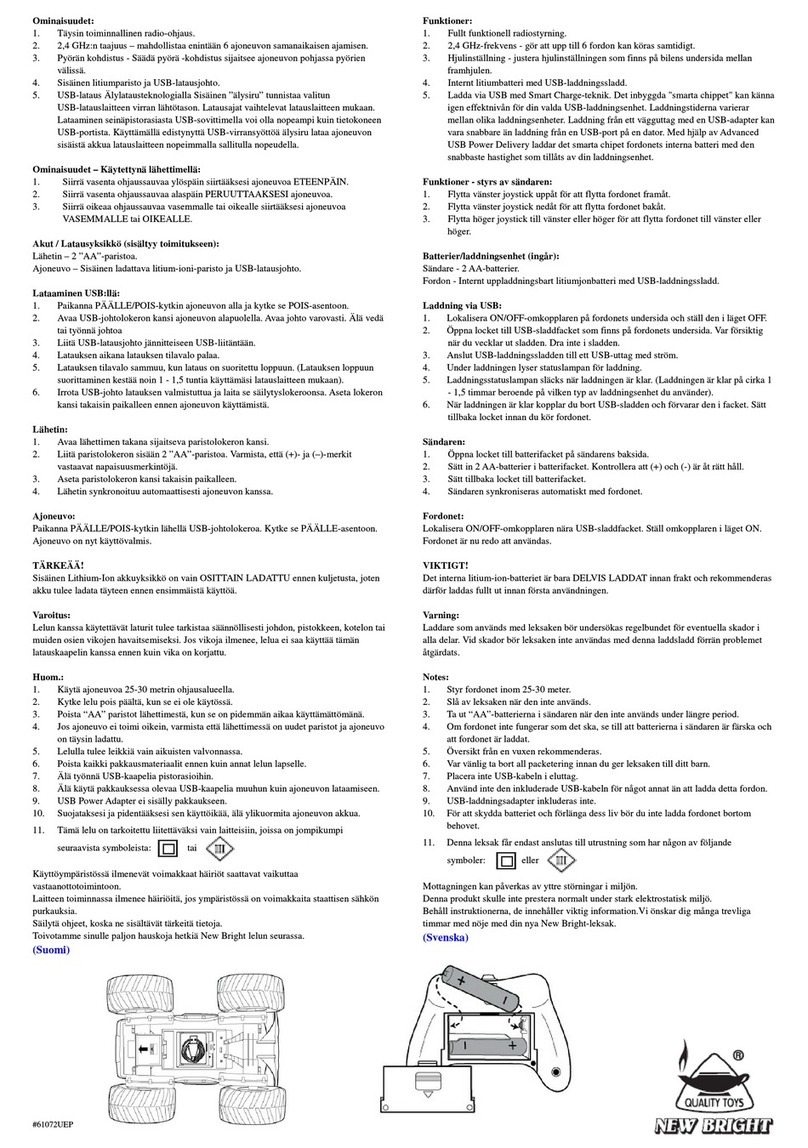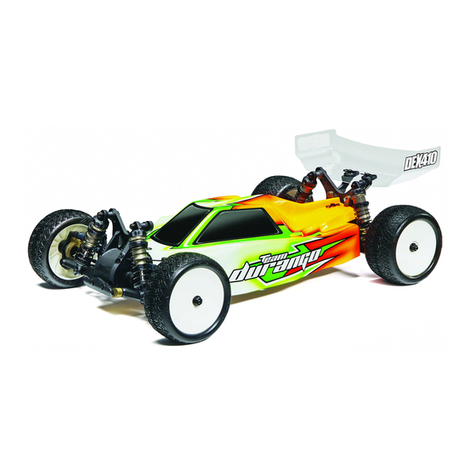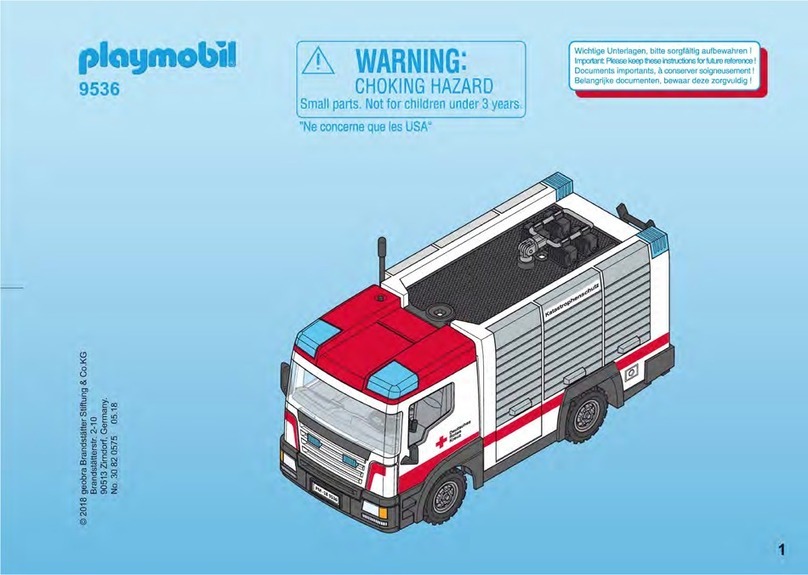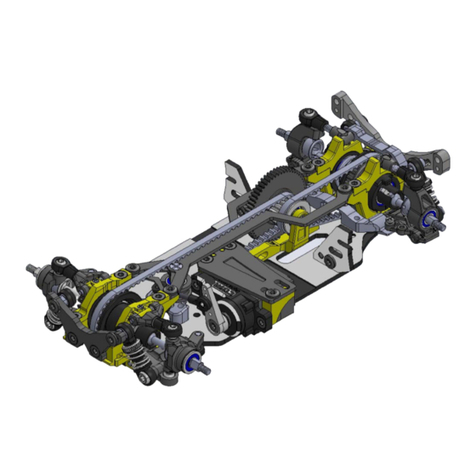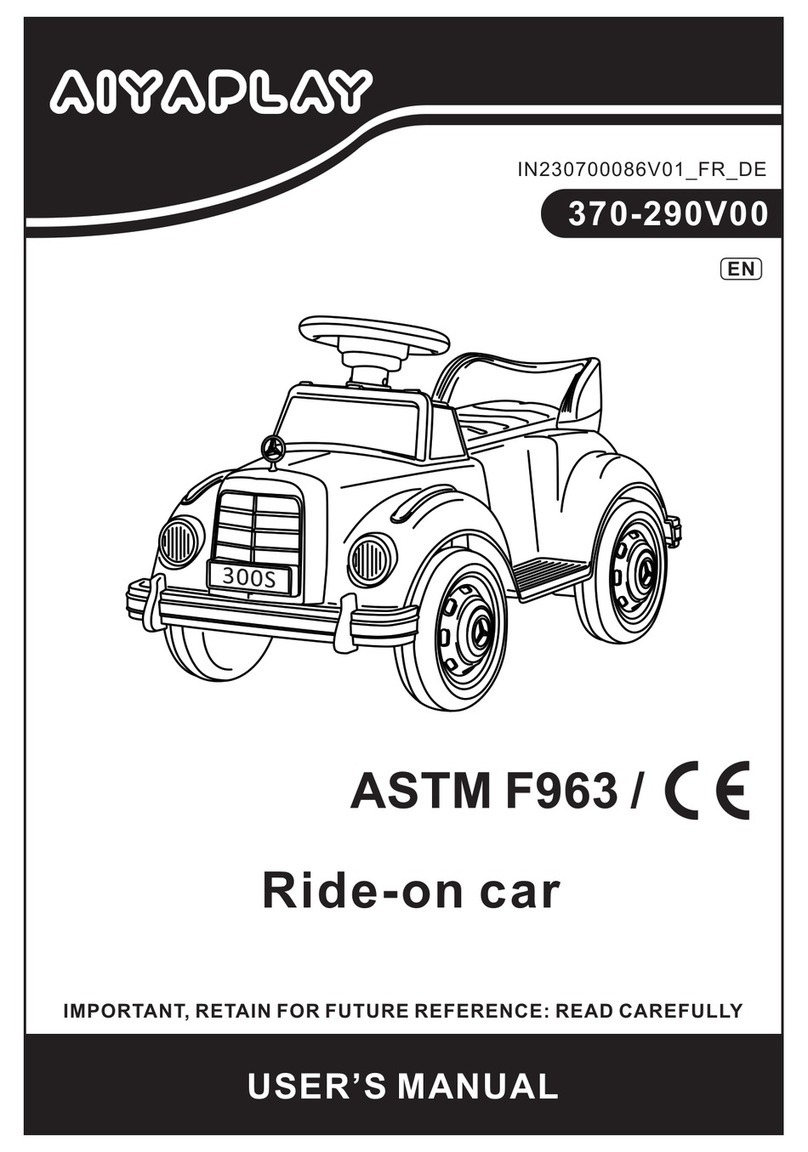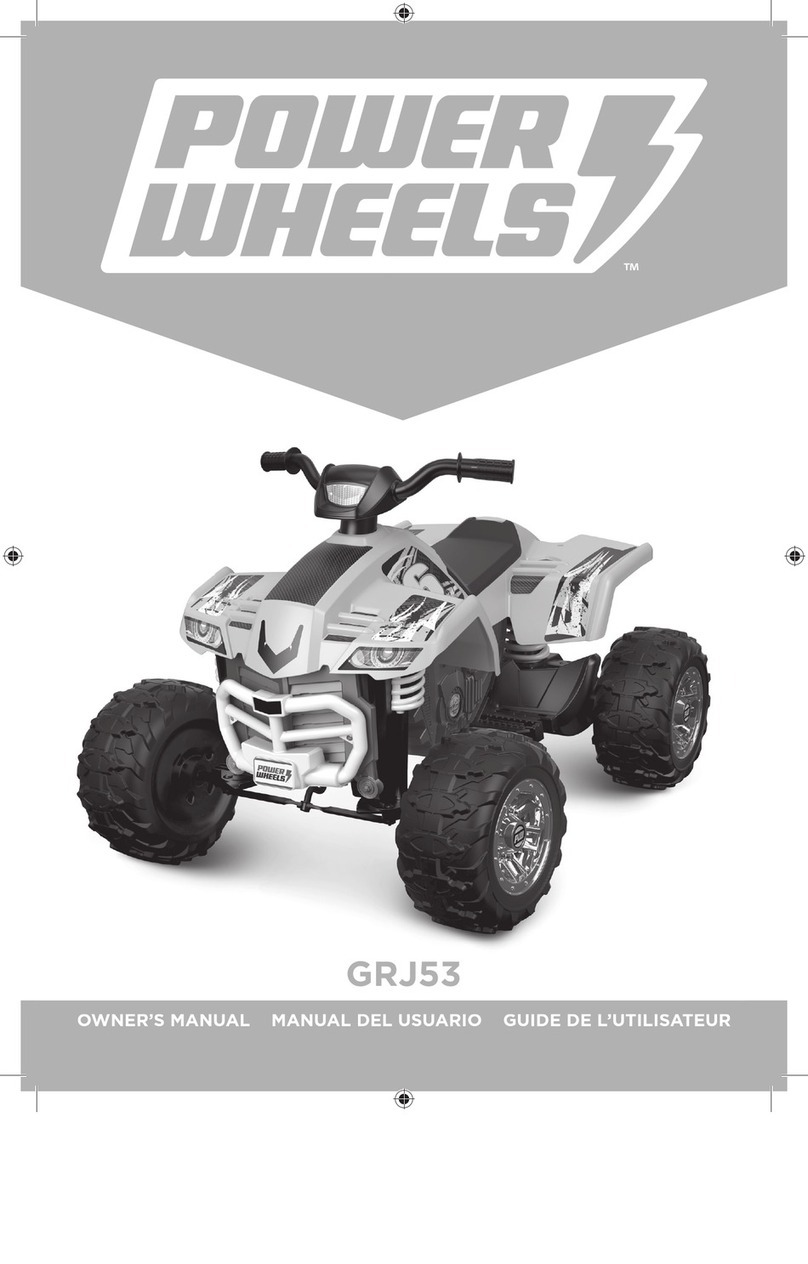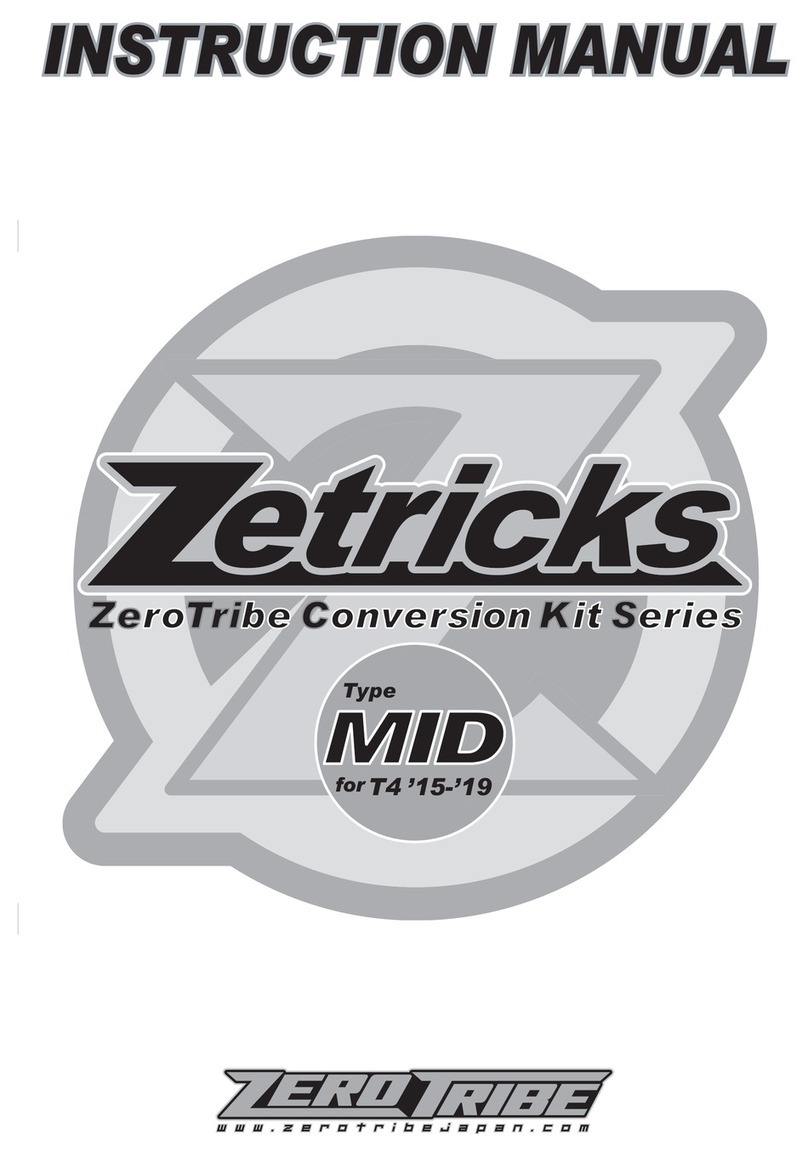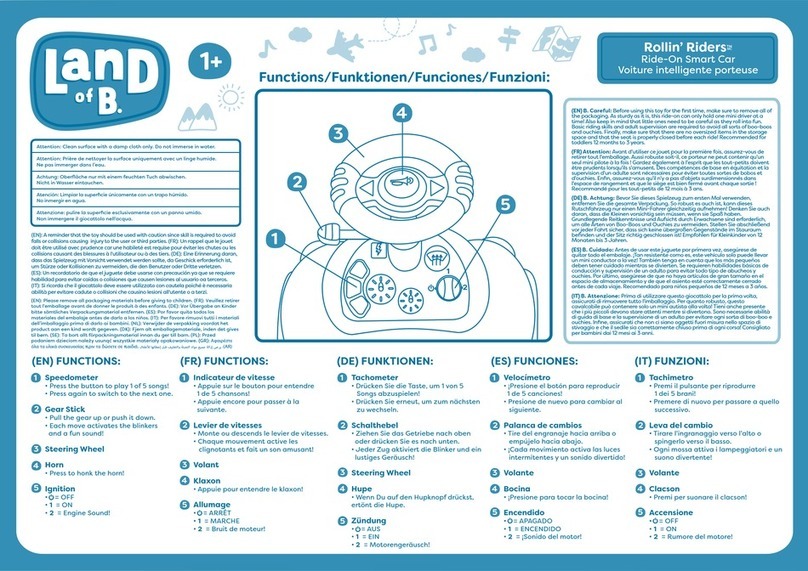
5
Apprendimento della corsa gas / freno
Per prestazioni ottimali, il regolatore deve essere calibrato. In tal modo, le tre
posizioni avanti, indietro e la posizione di folle devono essere specicata.
Durante la regolazione procedere come segue:
1. Accendete il radiocomando, durante che la ricevente è spento. (Attenzione con sistema di
Futaba: In certi casi la funzione del gas è invertita). La corsa servo deve essere in posizione
neutrale. Fare attenzione che la funziona ABS sia spenta.
2. Poi accendere la ricevente tramite l‘interruttore sul regolatore. Tenendo premuto il tasto ‚SET‘.
Questo vi porterà alla modalità di calibrazione, il LED inizia a lampeggiare. Appena il LED
lampeggia, rilasciare il pulsante. Se non si rilascia il tasto ‚SET‘ subito dopo il LED inizia a
lampeggiare e si entra nella modalità di programmazione. Se non si desidera questo, è
necessario a spegnere nuovamente il regolatore. La gura seguente mostra il processo d’inizio
di calibratura.
3. E´possibile congurare tre parametri:
Posizione neutra, Fine corsa marcia avanti, Fine corsa marcia indietro
4. Portare la leva del gas in posizione neutrale e premere il tasto ‚SET‘, il
LED verde lampeggia una volta e il motore emette un suono. Portare la leva del gas in posizione
nale per il movimento in avanti e premere il tasto `SET il LED verde lampeggia due volte e il
motore emette due suoni. Portare la leva del gas in posizione nale per il movimento indietro
e premere il tasto `SET`, il LED verde lampeggia tre volte e il motore emette tre suoni. Attendere
tre secondi, dopodiché è terminato il processo di calibrazione.
Throttle range calibration
To ensure that your ESC operates correctly it has to be calibrated. During this process the full
throttle, stop and brake positions will be set.
To calibrate the system, please proceed as follows:
1. Switch ON the transmitter. The throw should be set to neutral. If the transmitter is tted with an
ABS function this must be de-activated.
2. Press and hold down the ‘SET‘ button on the ESC and switch the receiver switch ON. The
LED will begin to blink. If you fail to release the
‘SET’ button the ESC will enter ‘Programming’ mode. If this
happens, you will have to switch the ESC o and start again to enter ‘Calibration’ mode.
3. Parameters can be set here:
Neutral point, Full throttle forwards, Full throttle reverse
4. Ensure that the throttle control is in the neutral position and press the ‘Set‘ button. The green
LED will ash once and the motor will omit a beep. Move the throttle control to the full throttle
(forwards) position and press the green ‘Set‘ button. The green LED will ash twice and the
motor will omit 2 bleeps. Move the throttle control to the full reverse position and press the
‘Set‘ button. The green LED will ash 3 times and the motor will omit 3 bleeps. 3 Seconds after
this procedure has been followed, the motor is ready for use.
Gusto presa sul SET Stampato interruttore Lasciate che il pulsante SET quando
le luci rosse lampeggiano crostate
Hold the SET keep button Turn on the switch Release the SET button as soon
as the red LEDstarts to blink
ON/OFF
1
ON/OFF
Set LED
Neutral point
rst click second click third click
Point of full throttle Point of full brake
2
LED verde
lampeggia una volta
Green LED ashes
once
LED verde
lampeggia due volte
Green LED
ashes twice
LED verde
lampeggia tre volte
Green LED
ashes thrice
Set
Set Set
IT - Allacciare la trasmittente alla ricevente
In un moderno sistema di 2,4 GHz, è indispensabile che la tras-
mittente e la ricevente vengano connesse insieme a bordo del
modello. La ricevente accetta quindi solo i segnali della trasmit-
tente. Se per qualsiasi motivo si dovesse eettuare un nuovo
allacciamento“connessione”, eseguire le seguenti operazioni:
A. Sostituire nella trasmettente le batterie scariche con altre
cariche o nuove. Lasciare spenta la trasmettente.
B. Inserire la spina di accoppiamento in dotazione nell’uscita
del canale 3.
C. Collegando la batteria con la ricevente, si accende il sistema
ricevente. Secondo la versione di software usata, la
ricevente segnala in modo dierente la modalità di
binding. (esempio: il Led può lampeggiare, restare
accesa o completamente spenta). Il processo di binding in
se è uguale per tutte le versioni. Il Led sulla ricevente inizia
lampeggiare e cosisegnala che la ricevente si trova in
modalità di binding.
D. Tenere premuto il pulsante di connessione sulla
trasmittente, mentre si accende la stessa.
E. Il trasmittente inizia a lampeggiare e cosi segnala che si
trova in modalità di binding.
F. Rilasciare il pulsante di connessione della trasmettente e
rimuovere la spina di connessione nella ricevente. Spegnere
laricevente e la trasmittente.
G. Adesso spegnete la trasmittente. Il sistema memorizza il
collegamento.
H. Installare correttamente tutti gli accessori e controllare con
molta attenzione.
I. Se la funzione non avesse successo, ripetere la procedura
di connessione.
L’illustrazione seguente mostra gra camente il processo di con-
nessione e speci ca gli elementi da utilizzare.
GB - Binding the receiver to the transmitter
As with all modern 2.4GHz R/C systems the receiver must be
bound to the transmitter to ensure that the receiver will only react
to signals from that transmitter.
If you wish to re-bind the receiver with the transmitter please pro-
ceed as follows:
A. Ensure that the transmitter is tted with fresh or fully charged
batteries and leave the transmitter o.
B. Plug the binding plug (included) into the channel 3 socket on
the receiver.
C. Switch the receiver system on by connecting the battery or
turn in a BEC operating on a controller to control. Depen-
ding on your software version of your receiver indicates
the dierent binding mode (instead of ashing lights for
example LED or remains out completely). The binding
process as such is in all versions. The receiver LED will be-
gin to ash indicating that the receiver is in bonding mode.
D. Press and hold down the binding button on the transmitter
whilst switching it on.
E. The transmitter will begin to ash indicating that the receiver
is in bonding mode.
F. Release the binding button on the transmitter and discon-
nect the receiver from the battery or turn o the controller.
Release the binding plug from the receiver.
G. Switch of the transmitter. And remove the binding wire. The
system be bound at the next start .
H. Install all properly and check anything very precisely.
I. If the receiver fails to bond or does not function after bond-
ing repeat the above procedure until a successful bonding is
achieved.
The diagram illustrate the bonding process and show the loca-
tions of the relevant components.
Programmazione del gruppo integrato di FailSafe
1. Descrizione della Funzione
L’unità FailSafe è concepita principalmente per l‘utilizzo sulle imbarcazioni e sui veicoli. Serve
per evitare la perdita del modello, determinando la chiusura del gas, nell’eventuale assenza
di segnale. Se la ricevente perde il segnale della trasmittente, il servo del gas o regolatore di
velocità ritorna automaticamente sulla posizione programmata inizialmente.
2. Impostazione
a. Accendere la trasmittente
b. Accendere la ricevente. Il segnale LED lampeggia continuamente e indica che la ricevente
è pronta.
c. Spostare sul trasmettitore la leva dell‘acceleratore nella posizione di freno, o zona spento
nel regolatore di velocità. Tenere la leva del gas su questa zona.
d. Premere il pulsante Imposta sul ricevitore. Il segnale LED lampeggia per 3 secondi (vedi
illustrazione a sinistra).
e. L‘impostazione è salvata e si può portare la leva dell’acceleratore in posizione neutra.
3. Prova delle impostazioni
a. Accendere la trasmittente.
b. Accendere la ricevente.
c. Spegnere la trasmittente.
d. Ora la ricevente perde il segnale e conduce il servo del canale gas o il regolatore di
velocità sulla posizione in precedenza programmata.
e. Seguire la procedura descritta sopra, il processo FailSafe funziona correttamente.
How to setup the fail safe function
1. The instruction of function
The function of protection of losing control is mainly for r/c boats and cars and keeps them
away from damage through throttle channel. When the receiver is out of control signal, the
receiver of throttle will automatically return to the initial position which set up before starting to
avoid the error action :
2. How to set the function
a. Switch on the transmitter power and enter into the working condition
b. Connect the receiver with power and enter into the working condition, the signal light on
receiver will blink
all the time.
c. Control the throttle of transmitter and keeps the servo or ESC in the neutral position.
d. Press the setting button, the LED will be ash for 3 seconds (see on pict. left).
e. Release the setting button. The setting is nished.
3. Testing
a. Switch on the transmitter and enter the working condition.
b. Contact the receiver with power and enter the working condition.
c. Turn o the power of transmitter.
d. The throttle of servo will be set automatically.
e. Finish these steps above means the setting is ok.
Bindungsstecker
Binding Plug
Fail Safe
Setup LED
2,4 GHz
Antenne
Antenna
Empfänger/Receiver


